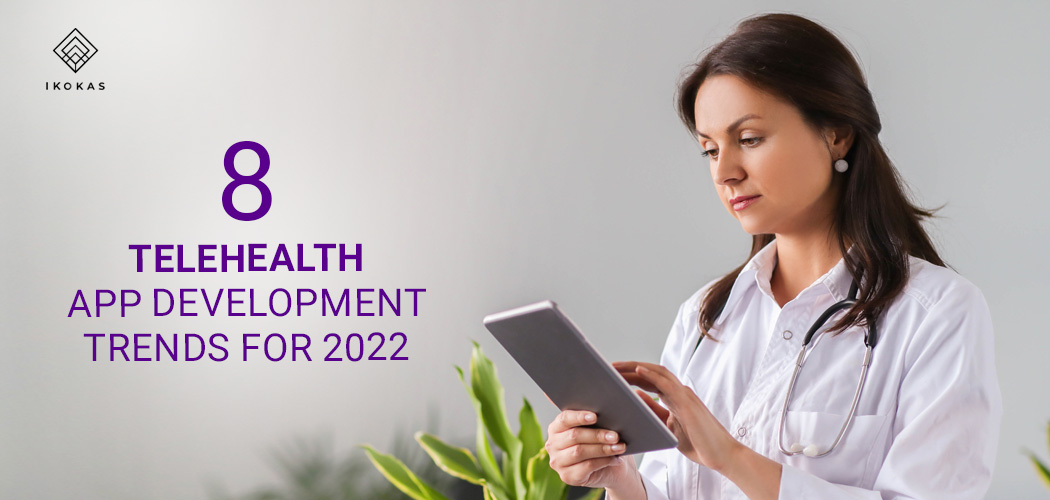8 Telehealth App Development Trends for 2022
The pandemic saw a sharp increase in demand for telehealth, but developments did not end there.
After the epidemic, the use of telehealth apps grew by 3800%, according to McKinsey, and there seems to be no turning back. Both patients and doctors value the convenience and accessibility it offers. Here are a few telehealth trends that you should be aware of before you start developing your app if you’re considering doing so.
The following 8 telehealth trends will rule in the upcoming years.
The development of wearables is one future trend in telemedicine that deserves attention. Let’s examine it more closely.
Increased app usage along with wearable device adoption
People avoided hospitals during the shutdowns because they didn’t feel safe visiting their doctors there. Even while telemedicine had existed for a while before the epidemic, it took off during the outbreak. We are seeing advancements in the telemedicine sector as tech developers and physicians collaborate more closely. Doctors need a mechanism to keep track of some patients; some require daily monitoring, even though the demand for remote healthcare is still at an all-time high.
Now that some inhalers can transfer data to apps and smart beds can also transmit data to doctors, doctors may monitor their patients’ EKG and ECG monitors as long as they have an internet connection. We may anticipate more wearable tech and corresponding apps as the Internet of Medical Things expands.
AR, VR, and MR will result in better diagnosis and treatment
Numerous telemedicine applications are now adopting AR and VR integration as a basic feature. A more accurate diagnosis may result from the establishment of an interactive virtual environment using Mixed Reality (MR). VR-enabled systems can also give real-time instructions to people with chronic pain on how to carry out crucial activities.
The use of AR applications in the treatment of neuropathic pain, other forms of physical and sports rehabilitation, and mental health disorders has immense promise. The observation of a patient’s mobility and 3D depiction using AR/VR also help to improve treatment.
Patient safety will increase thanks to Artificial Intelligence
Artificial intelligence technology will enable the development of a wide range of advanced telehealth applications by the year 2022. The use of chatbots, voice recognition, and automatic health alarms are just a few examples of how AI can be implemented into telehealth apps. AI-enabled features can help people cut down on wait times, make appointments, interact with specialists, and ask questions about their health.
Clinicians can swiftly review a patient’s medical history, analyze reports, create digital prescriptions, and provide ongoing support thanks to AI-enabled capabilities. AI can automate repetitive tasks and reduce the amount of labor a doctor needs to do, which can help to prevent burnout.
IoT solutions will advance, moving beyond wearables to include intelligent medications
IoT devices are now being used by 60% of healthcare companies worldwide, and this percentage is anticipated to grow significantly over the next several years. IoT is expected to rule the top telehealth and telemedicine future trends, it should be said. Take the “intelligent pill,” a notable and innovative product that shows promise. Patients can get data about their vital functions through a mobile phone app after the pill uses portable sensors to collect data.
IoT will have a big impact on improving medical device performance. Medical equipment that is mobile and portable will not only record data but also carry out specific tasks in response to commands or known circumstances.
The use of blockchain to secure patient data
The security of these vast amounts of data is a problem for the healthcare sector. Blockchain healthcare applications safeguard critical patient data. Blockchain has the amazing capacity to keep a transparent, decentralized, and incorruptible record of all patient data.
The sensitivity of medical data can be safeguarded by this openness as well as the capacity to hide a person’s identity behind complicated and secure codes. Blockchain is a technology that will be extensively employed in the creation of healthcare apps due to its decentralized nature.
Voice and intelligent listening technologies will expedite medical aid
In businesses other than technology, voice recognition and communication are already transforming the way that retail, customer service, and telemarketing are done. The healthcare sector will also make use of voice technologies. Apps geared toward healthcare professionals in particular will leverage voice technologies. The virtual healthcare assistant handles the potential anticipated to enhance medical planning and expedite medical support (such as inquiries into whether a patient has taken their medication or their reaction to the negative effects of their medications).
Voice mobile apps can generate encounter notes in less than 45 seconds by transcribing data received via dictation, which represents an excellent opportunity for the progress of HC VUI (Healthcare Voice User Interface technology). Smart listening devices will also assist in the elimination of manual documentation (Healthcare Voice User Interface technology).
More video, a stronger user experience emphasis, and more engagement tools
Without a question, telehealth apps will continue to gain favor with patients and healthcare professionals. This is a result of a growing trend where people use various digital platforms to stay connected and actively participate in their personal and health life.
– More frequent usage of video content: Since video is both entertaining and educational, it will continue to play a significant role in telehealth apps. By doing this, consumers will be able to learn more about certain medical conditions or treatments without having to personally consult a doctor or nurse.
– Increased user experience emphasis: Many developers are now putting more emphasis on making apps that are simple to use and navigate. As a result, patients won’t have to struggle for hours to understand how to use the app or endure annoyingly long loading times.
– User engagement tools: Telehealth apps should also provide tools that let patients communicate with their physicians and nurses from a distance. This can include tools like interactive questionnaires, discussion boards, and chatbots.
A new step toward cloud computing
Cloud computing is a telehealth trend to which we should pay attention. The immense influence it will undoubtedly have on the healthcare sector has only lately been realized, although it has long extended outside the boundaries of the global corporation. Therefore, the healthcare sector will still be seen as having a lot of potentials.
Numerous ways that cloud technology can and will support the healthcare industry. For instance, cloud services allow for quicker access to vital information for healthcare professionals and their patients. Furthermore, cloud infrastructure supports mHealth mobile apps. Healthcare providers give their staff access to information at any time and from any location by storing data and processing capacity in the cloud.
To sum it all up
The last few years have seen significant advancements in telehealth apps. Unquestionably, the sudden need for medical care during the pandemic has been a major factor. We can certainly predict that healthcare applications will be a significant part of patients’ life given how quickly the telehealth business will continue to expand well into 2022.
Future trends in telehealth and telemedicine that we’ve discussed in this article include a wider uptake of already available technologies like cloud computing, voice, and smart listening. Having said that, we may also look forward to several recent developments (now in the trial stage), such as the widespread adoption of intelligent medications.
Ikokas knows that UX/UI Design is an important marketing strategy in today’s world, where technology keeps getting better. Customers want things to work well, be easy to use, and be in a good place. Businesses do better when their brands meet these needs well. Good UX/UI design can definitely change how your business works. Ikokas focuses on user experience due to its importance for both small and large businesses.
Delhi NCR based Ikokas Digital Technologies has put together an expert in-house team that has been trained on UX/UI design projects to make sure that our clients from the world over can seamlessly meet the needs of discerning consumers who want a smooth interface on any screen, whether it’s a laptop, tablet, or smartphone.
All things considered, technology and medicine are now inextricably intertwined, and we are excited to see what the future brings! Connect with us here for a discussion.




